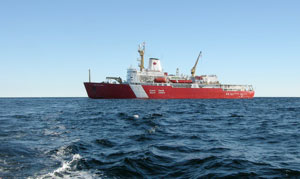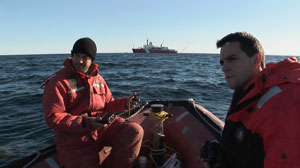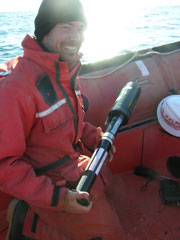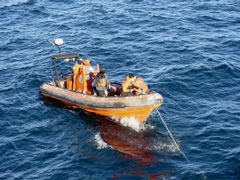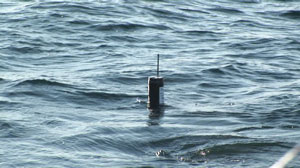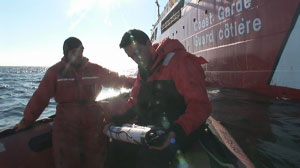Luc RainvilleAugust 1, 2007Today I got off the boat! Well, not for long; I'm not ready to leave, I love it up here. During a station we had the opportunity to put a small boat in the water and conduct a few operations near the Louis. For the past day or so, we have been working hard on a CTD line - a series of closely spaced stations - going up the continental shelf on the south side of the Beaufort Sea and near the Mackenzie river delta. We took advantage of being stopped for one of these stations to put a small boat in the water. There were 3 main motivations for doing this: Tim Kane (contractor at IOS) needed to launch an XCP (expendable current profiler, we've had trouble making it work from the Louis), the japanese media crew (3 people from ABC, a TV network in Japan filming the expedition to report on the arctic science and global warming) wanted to get on a small boat to take footage of the Louis from the water, and we wanted to use a small CTD to do a couple of upper ocean casts, by hand. We went on the little inflatable boat and spend about 45 minutes around the ship, first doing the XCP while being about 300 m away from 'home', then circled the boat and lowered and pulled a little CTD instrument by hand, and of course taking pictures of the ship. It was fun! There was no ice, but it was beautiful. During the cruise, Tim will deploy 10 XCPs, measuring currents in the upper 1500 m. These are sensors which fall through the water while recording the variations in magnetic field. As the water (an electrical conductor) moves through the Earth's magnetic field, it produces a current and in turn creates small perturbations in the magnetic field. Therefore, it's possible (although not trivial) to calculate what the velocity of the water is by measuring what the magnetic field is as a function of depth. Tim has been deploying these instruments for Jamie Morison, of the Applied Physics Laboratory, at the University of Washington in Seattle. The first one deployed off the stern of the ship a few days ago didn't work great, but this one worked beautifully.
Last updated: October 7, 2019 | |||||||||||||||||||||||||||||
Copyright ©2007 Woods Hole Oceanographic Institution, All Rights Reserved, Privacy Policy. | |||||||||||||||||||||||||||||


